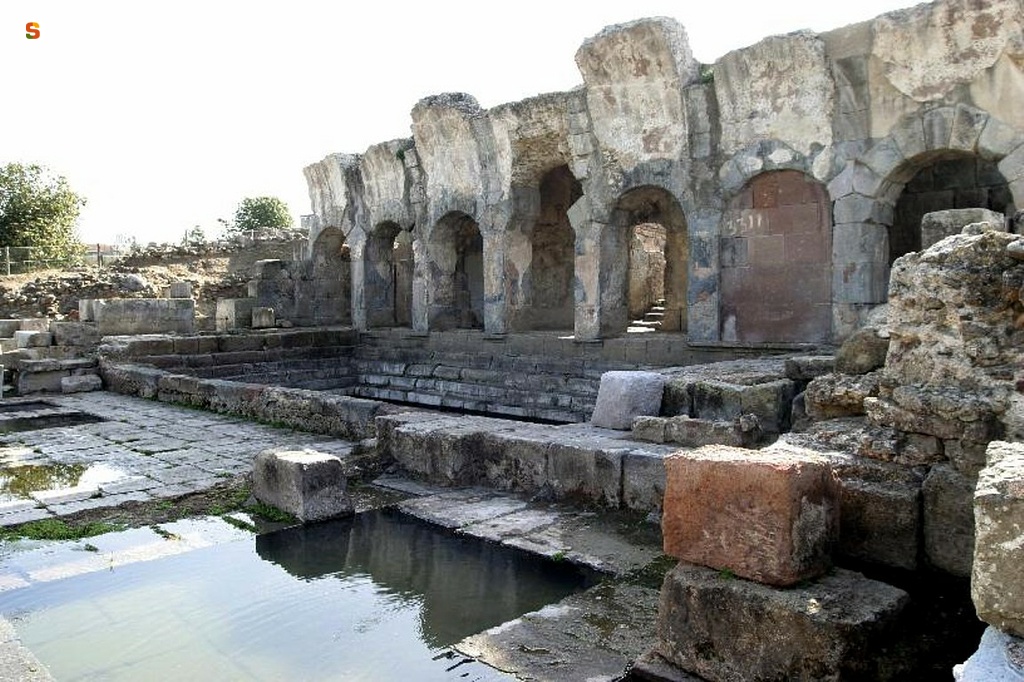The Fordongianus thermal complex, consisting of two separate establishments, is located on the left bank of the Tirso river, in the upper Oristano area.
The thermal complex, one of the most important in Sardinia, revolves around the urban site of “Forum Traiani” (hence the name Fordongianus). The town, founded late republican, was established by Trajan as a market center between the communities of the interior and the Romanized populations of the hinterland of the Gulf of Oristano. By the beginning of the 4th century AD, it was probably elevated to the rank of 'Municipium'.
The baths, the ancient “Aquae Ypsitanae”, are arranged on various levels and are composed of two establishments: the first, in N, of the first century A.D.; the second, in S, of the third century A.D.
The first plant exploited the waters that still flow today at a temperature of 54 °C from the alluvial layer above the volcanic bank. The water was harnessed by means of a cement wall with a double wall in square blocks of vulcanite, 3.5 m thick, which also served as an embankment to the floods of the Tirso.
The original structure of the plant must have been in “opus quadratum”, that is, in large squared blocks of stone; it later underwent several changes. At the center of the plant is the “natatio”, a large rectangular pool (m 13 x 6.5; depth m 1.5) for warm bathing (the hot thermal water was diluted by drawing cold water from tanks located upstream). The pool was covered with a barrel vault. The S and N sides were originally porticoed; the S porch remains with square pillars in vulcanite blocks and a barrel vault in cement work reinforced by rings of wedged volcanic blocks. Square skylights provided lighting. On the N side of the “natatio”, three quadrangular tanks were built, while on the E side there is a rectangular building with niches on the long sides; one of these has returned an altar consecrated to the nymphs by Servato, freedman of the emperor and prosecutor of the mines and imperial estates, for the healing of Quinto Bebio Modesto, governor of Sardinia close to the emperors Caracalla and Geta (211-212 AD).
The second plant, in S, occupies a rectangular area (m 30 x 12) whose “opus quadratum” structures are probably an incorporated part of the first plant. Made of “opus vittatum mixtum”, it probably had its original entrance overlooking the paved square in S. From the entrance you could access the dressing room (“apodyterium”), the “frigidarium” (rectangular room with two tanks), the “tepidarium” (rectangular environment), and the “calidarium” (room with rectangular tub). In contrast to the first, the water heating of the second plant was artificial. The water supply was guaranteed, by means of an efficient sewer network, by a system of wells and tanks partly fed by the Roman aqueduct.
The connection between the two factories was secured by a staircase that overlooked the porch of the 'natatio'.
The square behind, paved with vulcanite, has a trapezoidal shape (25 x 30 x 25 m). On the eastern side, there is an “L” building, in “opus vittatum mixtum”, with five rooms and two rectangular rooms; one of these is frescoed with chandelier and griffin motifs, dating back to 200 A.D. The building could be a “hospitium” linked to thermal environments.
History of excavations
The first to indicate the location of the “Aquae Ypsitanae” and “Forum Traiani” in the territory of the current Fordongianus was the historian Giuseppe Manno (1825). The first archaeological excavations took place between 1899 and 1902, and were conducted by the Royal Commissioner of Museums and Excavations of Antiquities in Sardinia. Starting in 1969, the Superintendence for Archaeological Heritage of the Provinces of Cagliari and Oristano has resumed systematic investigations at the site.
Bibliography
R. Zucca, Fordongianus. Sassari, C. Delfino, 1986 (Archaeological Sardinia. Guides and itineraries; 4);
P. Meloni, Roman Sardinia, Sassari, Chiarella, 1990;
S. Angiolillo, The Art of Roman Sardinia, Milan, Jaca Book, 1998;
R. Zucca, Journey into the Archaeology of the Province of Oristano, Oristano, E.P.T. Oristano, 2004; A. Mastino, Ancient Sardinia, Nuoro, Il Mistrale, Nuoro, 2005.
Structure category: archaeological area or park
Content type:
Archaeological complex
Archaeology
Usability: Open
Province: Oristano
Common: Fordongianus
Macro Territorial Area: Central Sardinia
POSTAL CODE: 09083
Address: località Caddas, lungo fiume Tirso
Telephone: +39 0783 60157
E-mail: info@forumtraiani.it
Website: www.forumtraiani.it
Facebook: www.facebook.com/ForumTraiani
-
Summer - Autunnale
Monday - Tuesday - Wednesday - Thursday - Friday - Saturday - Sunday
9:30 AM - 7:30 PM
Monday - Tuesday - Wednesday - Thursday - Friday - Saturday - Sunday
9:30 AM - 5:30 PM
Information on tickets and access: It is advisable to check for any changes in hours by contacting Soc. Coop. Forum Traiani at +39 0783 60157 before the visit.
Access mode: For a fee
Tickets :
Services information: Multilingual audio guides are available in French, English, German, Spanish. The educational workshops (upon reservation) are aimed at students of: kindergarten, primary and first grade secondary school. The educational tour can be carried out both in the morning and in the afternoon, it is also possible to include lunch.
Other services: Specific visit itinerary for children.
Update
Services
Teaching room
Audiooguide
Guided tours
Where is it
Images


Results 2 of 113294
View AllVideo
Comments